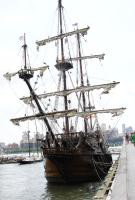 Today I went aboard El Galeon Andalusia, at South Street Seaport. The ship is billed as “a 170 foot, 495 ton, authentic wooden replica of a galleon that was part of Spain’s West Indies fleet.” It is a intriguing ship that has successfully sailed thousands of miles, including crossing the Atlantic. The original galleons, and the carracks that preceded them, were the ships that first girded the globe in 16th and 17th centuries. They changed the vast oceans from barriers to highways. For good and/or ill, these ships literally changed the course of the world’s civilizations.
Today I went aboard El Galeon Andalusia, at South Street Seaport. The ship is billed as “a 170 foot, 495 ton, authentic wooden replica of a galleon that was part of Spain’s West Indies fleet.” It is a intriguing ship that has successfully sailed thousands of miles, including crossing the Atlantic. The original galleons, and the carracks that preceded them, were the ships that first girded the globe in 16th and 17th centuries. They changed the vast oceans from barriers to highways. For good and/or ill, these ships literally changed the course of the world’s civilizations.
The only problem with Galeon Andalusia is that the description “authentic wooden replica” promises a bit too much. The hull is primarily fiberglass, sheathed in wood above the waterline. There is nothing actually wrong with this. Fiberglass is far easier to maintain than a wooden hull. If the description merely becomes “authentic replica” things might be OK.
On the other hand, one might question the authenticity of some other details. There is a prominent ship’s wheel on the quarterdeck, which the young guide claimed was authentic to the period. From all I have read, the first ship’s wheels appeared in the early 18th century, whereas this ship is intended as a late 16th century replica. To be fair, Galeon Andalusia was built to be sailed, and having a ship’s wheel, as opposed to a period-appropriate whipstaff, would make the ship far easier to handle and require fewer crew. So, here again, the anachronistic wheel may be OK.
I did see a sign near the wheel that for an additional fee, one could have your picture taken wearing pirate garb. I saw a pile of plastic cutlasses and “pirate” hats and vests sitting on the deck. (I don’t think that plastic cutlasses date from the 16th century either.) I did not choose to get my picture taken.
On the tween deck, the headroom was more than ample, probably around 7′ which is another anachronism, though again understandable for a ship designed for modern visitors. The space is used as a gallery explaining the history of galleons and of the ship, was well as playing looping video of the ship under sail. A movie of the construction of the ship also was playing in a small theater set up in the hold.
 On deck, the rigging was very interesting. The multipart knights-head halyard blocks (I may be messing up the terminology here. If anyone knows better, please correct me) used for raising the topmast yard appeared both beautiful and functional.
On deck, the rigging was very interesting. The multipart knights-head halyard blocks (I may be messing up the terminology here. If anyone knows better, please correct me) used for raising the topmast yard appeared both beautiful and functional.
16th century ships didn’t reef their sails, which is to say reduce the area of a sail by gathering it up from the top. Instead, 16 century sailors untied lower sections of the sails, referred to as a bonnet, which was laced to the bottom of the sail. Though the sails were all furled, I could still see the bonnet lacings from where I stood on the main deck.
The only sour note on deck was that the mizzen, main and fore tops were roughly rectangular. Every drawing or painting that I have seen of the period showed ships with round tops, often mistaken for “crows nests.” Why they didn’t make the tops round is unclear. (They also used steel futtock shrouds, which I would have happily overlooked if the rectangular tops had not seemed so out of place.) Interestinly enough, the sprit topsail platform, however, is round.
Last week, I ran into artist Frank Hanavan who was painting en plein air on Pier 15 with l‘Hermione and El Galeon Andalusia tied up along either side. He commented that it was a shame that the two ships were so close together. l’Hermione, built using largely original materials and using original construction techniques, sets the gold standard for replicas, whereas El Galeon Andalusia represents some of the necessary compromises that often need to be made with replica vessels.
It may not be entirely wooden, nor always authentic, but El Galeon is nevertheless, a fascinating ship. El Galeon will be at Pier 15, at South Street Seaport, NY through July 12th. Click here for tickets.

Nothing artificial about this one – https://www.youtube.com/watch?v=DnYX6nesGF0&feature=youtu.be
thanks for the “inside report!” we didn’t get a chance to board her when she was down in Philly.
Would like to see several close photos of the clew/earring/bowline cringle and roping job on one of the sails on this “Galleon”. Just a point of interest.
Rick Spilman was quite right to query his terminology when referring to “knights head”. I believe “knights head” is the extension of the stem underneath the bowsprit, to which the bowsprit is sometimes lashed. The term he was looking for is probably the “partners”, which is the area where a mast goes through the deck.
But a very good report that was a pleasure to read.